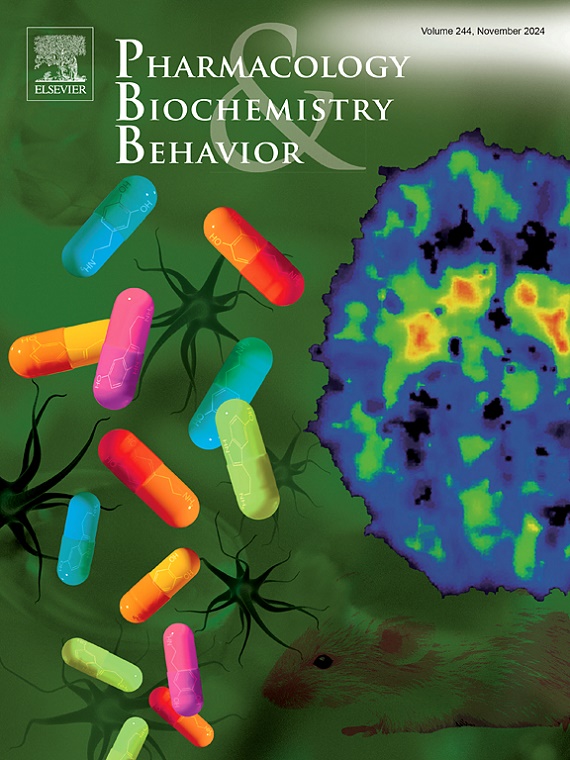PERK activation mediates neuroprotection against chronic unpredictable stress-induced neurobehavioral changes via the TFEB pathway
IF 3.3
3区 心理学
Q1 BEHAVIORAL SCIENCES
引用次数: 0
Abstract
Chronic unpredictable stress (CUS) is a significant contributor to neurobehavioral changes, via disrupted cellular homeostasis, corticosterone and altered neurotransmitter dynamics. The PERK (Protein Kinase RNA-like Endoplasmic Reticulum Kinase)-TFEB (Transcription factor EB) pathway integrates stress responses with autophagy and lysosomal biogenesis to maintain cellular resilience, influencing oxidative stress, neuroinflammation and neurodegeneration. Hence, this study was intended to explore the possible involvement of PERK-TFEB pathway in mediating the neuroprotective effects of SB202190 (a PERK activator) in mitigating neurobehavioral changes induced by CUS. For evaluating the impact pharmacological interventions on neurobehavioral alterations, the Swiss albino either sex mice were subjected to different stressors for 8 weeks. The parameters for anxiety-like behaviour, depressive-like behaviour and memory impairment were assessed by elevated plus maze, sucrose preference test, tail suspension test, forced swim test, Morris water maze and passive avoidance task. The levels of corticosterone, dopamine, serotonin, biochemical parameters of oxidative stress, inflammatory mediators, and acetylcholinesterase (AChE) activity along with the histological changes were also examined. Administration of SB202190 (5 and 10 mg/kg) improved anxiety-like behaviour, depression-like behaviour, spatial learning and memory retention, histological changes; restored corticosterone, dopamine levels, AChE activity, oxidative stress and inflammatory markers and serotonin levels in CUS-exposed mice compared to controls. Molecular docking studies were carried out to reveal the binding interaction of SB202190 with TFEB, suggesting that it may modulate TFEB activity. It was also observed that these neuroprotective effects of SB202190 were significantly abolished by pre-treatment with eltrombopag (50 mg/kg, p.o.), a TFEB inhibitor, which signifies the involvement of TFEB signalling in protective mechanism of SB202190 that may have resulted in enhancement of TFEB-mediated autophagy. Therefore, this study highlights the critical role of PERK- TFEB pathway in neuroprotection as well as highlights mechanism and therapeutic potential of SB202190 in alleviating neurobehavioral changes and memory dysfunction associated with chronic unpredictable stress.
PERK激活通过TFEB途径介导慢性不可预测的应激诱导的神经行为改变的神经保护。
慢性不可预测应激(CUS)是神经行为改变的重要因素,通过破坏细胞稳态、皮质酮和改变神经递质动力学。PERK(蛋白激酶rna样内质网激酶)-TFEB(转录因子EB)通路将应激反应与自噬和溶酶体生物发生结合起来,维持细胞弹性,影响氧化应激、神经炎症和神经退行性变。因此,本研究旨在探讨PERK激活剂SB202190在减轻CUS诱导的神经行为改变中的神经保护作用可能参与PERK- tfeb通路。为了评估药物干预对神经行为改变的影响,对瑞士白化小鼠进行了8 周的不同压力刺激。采用升高+迷宫、蔗糖偏好测试、悬尾测试、强迫游泳测试、Morris水迷宫和被动回避任务评估焦虑样行为、抑郁样行为和记忆障碍参数。同时检测皮质酮、多巴胺、血清素、氧化应激生化指标、炎症介质、乙酰胆碱酯酶(AChE)活性及组织学变化。给药SB202190(5和10 mg/kg)改善焦虑样行为、抑郁样行为、空间学习和记忆保留、组织学改变;与对照组相比,cu暴露小鼠的皮质酮、多巴胺水平、乙酰胆碱酯酶活性、氧化应激、炎症标志物和血清素水平均有所恢复。分子对接研究揭示了SB202190与TFEB的结合作用,提示其可能调节TFEB活性。我们还观察到,SB202190的这些神经保护作用被TFEB抑制剂eltrombopag(50 mg/kg, p.o)预处理后显著消除,这表明TFEB信号参与了SB202190的保护机制,可能导致TFEB介导的自噬增强。因此,本研究强调了PERK- TFEB通路在神经保护中的关键作用,以及SB202190缓解慢性不可预测应激相关的神经行为改变和记忆功能障碍的机制和治疗潜力。
本文章由计算机程序翻译,如有差异,请以英文原文为准。
求助全文
约1分钟内获得全文
求助全文
来源期刊
CiteScore
6.40
自引率
2.80%
发文量
122
审稿时长
38 days
期刊介绍:
Pharmacology Biochemistry & Behavior publishes original reports in the areas of pharmacology and biochemistry in which the primary emphasis and theoretical context are behavioral. Contributions may involve clinical, preclinical, or basic research. Purely biochemical or toxicology studies will not be published. Papers describing the behavioral effects of novel drugs in models of psychiatric, neurological and cognitive disorders, and central pain must include a positive control unless the paper is on a disease where such a drug is not available yet. Papers focusing on physiological processes (e.g., peripheral pain mechanisms, body temperature regulation, seizure activity) are not accepted as we would like to retain the focus of Pharmacology Biochemistry & Behavior on behavior and its interaction with the biochemistry and neurochemistry of the central nervous system. Papers describing the effects of plant materials are generally not considered, unless the active ingredients are studied, the extraction method is well described, the doses tested are known, and clear and definite experimental evidence on the mechanism of action of the active ingredients is provided.

 求助内容:
求助内容: 应助结果提醒方式:
应助结果提醒方式:


